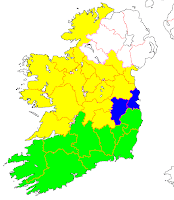Terms of Reference
The terms of reference of the Constituency Commission are set out in the Electoral Act of 1997 with subsequent amendments. It lays out fairly clearly the scope within which the Commission have to act in preparing their report.- The number of TDs shall be between 153 and 160. This is a reduction from the original range of 164-168. As far as I know, in previous reviews the Minister issued a further instruction to keep the number of TDs static at 166. This is the first time that the Commission has had free reign to chose the final number of TDs for the country.
- All constituencies must have 3, 4 or 5 TDs. Gone are the days of 8 and 9 seaters which may be for the best.
- Constituencies must remain within county boundaries if possible. It always amuses me that we are so wedded to the English imposed system of counties, especially the strength county identity has in politics and the GAA. But people seem to like voting along county lines so we try to match our dividing to the pre-existing, arbitrary carve up.
- Each constituency must be contiguous. This is a good thing™ as enclaves and exclaves just make for confusion.
- Constituency boundaries should be aware of geographic features such as rivers, mountains and major roads and use them appropriately. There is also mention of awareness of population density which I'm not really sure about. Does it mean that each constituency should try to have the same density, which I don't think could work, or that the population density across a constituency should try to be uniform - ie keep urban areas together in one constituency and rural in another?
- There should be some consistency between the constituencies before and after the review. This rules out a wholesale redrawing of the map. I'm not surprised this was added by politicians when drawing up the legislation as who wants to have to learn about a whole new constituency every election. However, it does rule out a project like eliminating 3 seaters entirely.
There are two ways to reduce TD numbers. Firstly you can reduce the number of constituencies by splitting say a four seater and divesting its territory into three surrounding constituencies while only adding a single new TD to each. The alternative is to keep the number of constituencies fixed and turn 5 seaters into 4 seaters and 4s into 3s while shuffling a few DEDs around to keep the population ratios in check. The former is directly at odds with continuity but the latter reduces the overall representativeness of the Dáil.
European Constituencies
While Ireland is historically divided into 4 provinces, for European electoral purposes the split is done slightly differently - Dublin forms a constituency on its own, Munster minus Clare is called South, Leinster minus Dublin, Longford and Westmeath forms East and then Connacht, Ulster along with Clare, Longford and Westmeath make up the North West constituency. With only twelve seats to be distributed that makes each constituency a three seater. The table below shows the distribution of population in each of the four regions.As can be seen, Dublin is under-represented compared to the rest of the country with only the South region being close to the average. However, in a four way split, there is no straightforward way to remedy this without sub-dividing Dublin further, perhaps moving the Dublin North constituency into East.
An alternative solution that substantially reduces the variance is to re-draw the boundaries to form three constituencies of four seats each. In this scheme I create East, North and South. East consists of Dublin and Kildare. I then extend a line across the south border of Laois and Offaly as far as the Shannon and then down the river to the sea. All counties above the line form the North constituency with those below forming South. The numbers for this division are shown below.
 While East is now slightly over represented at the expense of the other two regions, the variances are much smaller. The North constituency now also stretches from Malin Head to Abbeyleix, but considering the existing North West already goes as far as Cratloe outside Limerick it's not much longer. While it may not suit the North candidates to have to canvass such a large area, as the Presidential election showed, even on a small budget, a campaign can cover a large area if properly planned.
While East is now slightly over represented at the expense of the other two regions, the variances are much smaller. The North constituency now also stretches from Malin Head to Abbeyleix, but considering the existing North West already goes as far as Cratloe outside Limerick it's not much longer. While it may not suit the North candidates to have to canvass such a large area, as the Presidential election showed, even on a small budget, a campaign can cover a large area if properly planned.


No comments:
Post a Comment